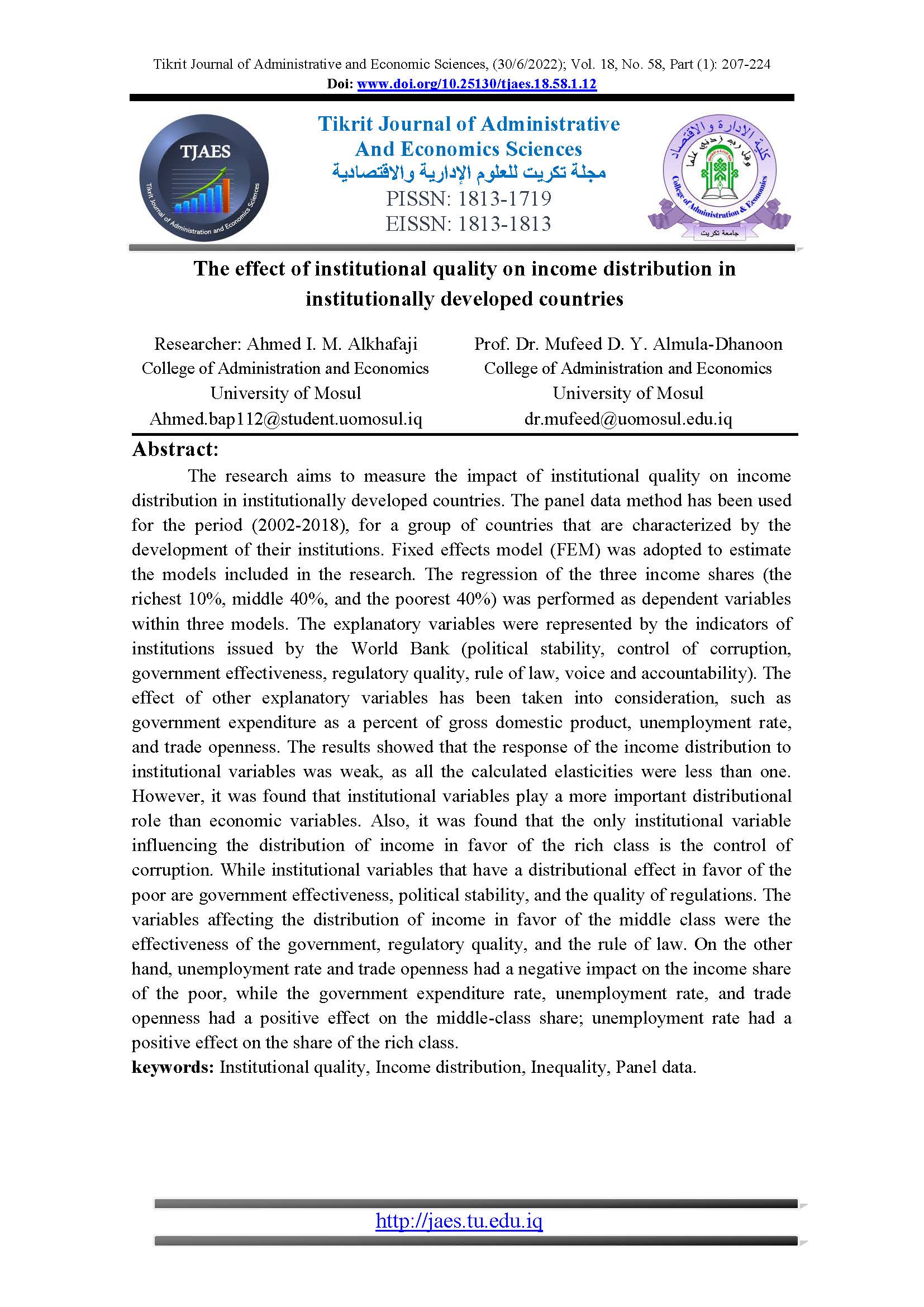The effect of institutional quality on income distribution in institutionally developed countries
Main Article Content
Abstract
The research aims to measure the impact of institutional quality on income distribution in institutionally developed countries. The panel data method has been used for the period (2002-2018), for a group of countries that are characterized by the development of their institutions. Fixed effects model (FEM) was adopted to estimate the models included in the research. The regression of the three income shares (the richest 10%, middle 40%, and the poorest 40%) was performed as dependent variables within three models. The explanatory variables were represented by the indicators of institutions issued by the World Bank (political stability, control of corruption, government effectiveness, regulatory quality, rule of law, voice and accountability). The effect of other explanatory variables has been taken into consideration, such as government expenditure as a percent of gross domestic product, unemployment rate, and trade openness. The results showed that the response of the income distribution to institutional variables was weak, as all the calculated elasticities were less than one. However, it was found that institutional variables play a more important distributional role than economic variables. Also, it was found that the only institutional variable influencing the distribution of income in favor of the rich class is the control of corruption. While institutional variables that have a distributional effect in favor of the poor are government effectiveness, political stability, and the quality of regulations. The variables affecting the distribution of income in favor of the middle class were the effectiveness of the government, regulatory quality, and the rule of law. On the other hand, unemployment rate and trade openness had a negative impact on the income share of the poor, while the government expenditure rate, unemployment rate, and trade openness had a positive effect on the middle-class share; unemployment rate had a positive effect on the share of the rich class.
Downloads
Article Details
References
Asgher N., Hafeez ur Rehman, A. Mumtaz, (2018), Impact of Institutional Quality, Energy Prices and Financial Development on Income Inequality: Evidence from Selected Asian Countries, Journal of the Research Society of Pakistan. Volume No. 55, Issue 1, pp. 243-251
Carmignani F, (2004), Institutional efficiency, political stability, and income dynamics, United Nation Economic Commission for Europe (UNECE), pp. 1-27. https://econwpa.ub.uni-muenchen.de/econ-wp/pe/papers/0503/0503007.pdf
Chong A, C. Calderon, (2000), Institutional Quality and Income Distribution, journal Economic Development and cultural change, Volume 48, Number 4, PP. 761-786. DOI: https://doi.org/10.1086/452476
Chong A, G. Mark, 2004, Inequality and Institutions, Working Paper, No, 506, Inter-American Development Bank, Research Department Washington, DC. PP. 1-41
Josifidis K., N. Supić, E. Pucar, (2017), Institutional Quality and Income Inequality in the Advanced Countries, Panoeconomics, Vol, 64, Issue 2 (Special Issue), pp. 169-188. DOI: https://doi.org/10.2298/PAN1702169J
Josifidis K., N. Supić, S. Bodor, (2020), Institutional Reforms and Income Distribution: Evidence from Post-Transition EU Countries, Panoeconomics, Vol, 67, Issue3 (Special Issue), pp. 309-331. DOI: https://doi.org/10.2298/PAN2003309J
Kunawotor M, G. Bokpin, C. Barnor, (2020), Drivers of income inequality in Africa Does institutional quality matter, African Development Review, Volume 32, Issue 4, pp. 718-729. DOI: https://doi.org/10.1111/1467-8268.12473
Madani G., (2019), Probing institutional quality through ethnic diversity, income inequality and public spending, Soc Indic Res, 142, pp. 581–595. DOI: https://doi.org/10.1007/s11205-018-1924-1
Nallari, Raj, Griffith, Breda, 2011, Understanding Growth and Poverty: Theory, Policy, and Empirics. Directions in Development poverty, World Bank. DOI: https://doi.org/10.1596/978-0-8213-6953-1
Nigar N, (2015), The Composite Impact of Institutional Quality and Inequality on Economic Growth, The Pakistan Development Review, 2015, vol. 54, issue 4 pp. 779–791. DOI: https://doi.org/10.30541/v54i4I-IIpp.779-791
North D., 1991, Institutions, the Journal of Economic Perspectives is currently published by American Economic Association. Journal of Economic Perspectives- Volume 5, Number 1, pp. 97-112. DOI: https://doi.org/10.1257/jep.5.1.97
https://pubs.aeaweb.org/doi/pdfplus/10.1257/jep.5.1.97
Perera, L, G. Lee, (2013), Have economic growth and institutional quality contributed to poverty and inequality reduction in Asia. Journal of Asian Economics 27 (2013), PP. 71-86. DOI: https://doi.org/10.1016/j.asieco.2013.06.002
Persson, G. Tabellini (2000), Political economics, MIT Press Cambridge, MA.
Savoia A, J. Easaw, A. McKay, (2010), Inequality, Democracy, and Institutions: A Critical Review of Recent Research, World Development Vol. 38, No. 2, 2010, PP. 142-154. DOI: https://doi.org/10.1016/j.worlddev.2009.10.009
Siyakiya P, (2017), the impact of institutional quality on economic performance: an empirical study of European Union and prospective member Counters, world Journal of applied economics, 3 (2), pp. 3-24. DOI: https://doi.org/10.22440/wjae.3.2.1
file:///C:/Users/Dell/Downloads/document %20 (6).pdf
World Bank, (2021), world Development Indicators, on line data.
World bank, (2021), Worldwide Governance Indicators, On line data,
http://info.worldbank.org/governance/wgi/
Zhuang J, E. de Dios, A. Lagman-Martin, (2010), Governance and Institutional Quality and the Links with Economic Growth and Income Inequality: With Special Reference to Developing Asia, ADB Economics Working Paper Series No. 193. https://www.adb.org/sites/default/files/publication/28404/economics-wp193.pdf. DOI: https://doi.org/10.2139/ssrn.1619116


